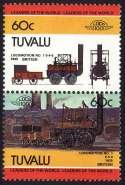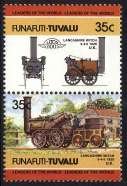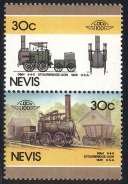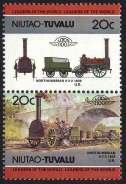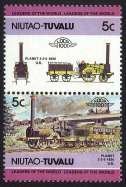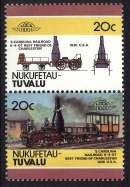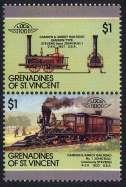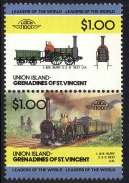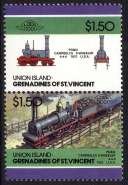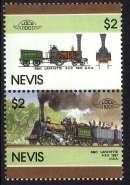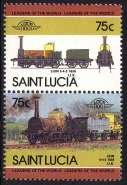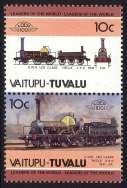

What is the train on the Wyman's Local Post stamp of 1844?
|
|

Lot 387, Siegel Auction Galleries Sale 830, The Hall Collection of United States Carriers, Locals and Western Expresses. |
|
I constructed this page in an effort to answer a question sent me by collector and U.S. Philatelics Classics Society (USPCS) member Gordon Stimmel on 6/16/2001, as follows:
I am writing an article on postal history of Wyman's local for a stamp journal over the next two weeks and hope you may help with a tidbit of information. Can you tell me what model locomotive is on the Wyman stamp? Was it wood or coal-fired? It looks a bit like the Brother Jonathan model but stack is different. And what was the car behind it? Passenger carrier or mail coach?
I do not own a copy of the stamp in question, so I got out my copy of the ATA Handbook, World Railways Philatelic, which I knew had an image of the Wyman's stamp on its cover. Unfortunately, that cover image was not very clear on my copy, so I looked through my collection of auction catalogs and found the image at the top of this page. I scanned it to enlarge it to my tastes. Then I returned to the ATA handbook - it had the following description of the stamp in question: "Early steam locomotive and passenger coach". Not much help. I consulted my library, which includes about a dozen volumes with illustrations of early locomotives, hoping I could find an image that looked like what was on the stamp, but found nothing. That seemed to be as far as I could go on my own, so I sent an inquiry to Norm Wright, editor of that ATA Handbook. He replied as follows:
The Scott U.S. Specialized Catalogue lists the Wyman local on Page 361 of the 2001 edition, but says little if anything more about it than does the Handbook. In fact, the Scott illustration is a bogus drawing {but see below}, while the reproduction on the cover of HB-138 is enlarged and enhanced (pen cancel removed) by computer from a known genuine. Scott does not show a value for the stamp unused, as it is not known to exist without either a manuscript cancel or handstamp -- one or the other of which are believed to have been applied always at the time the stamp was purchased and placed on the document or parcel to be mailed. It was probably not sold singly or in bulk to users, but paid for by the sender and then applied and "canceled" by the agent. Bill Weinberger, who influenced me to use this for the cover and "steered" me to the copy we used to reproduce for the cover, may know more.
I decided I might as well query ALL of the experts I knew, so I did that via e-mail, and received the following two replies:
From Don Kesler
I've done a little research on the same issue - the only thing I've been able to determine is that the "Wyman Post Office" was established in Boston to carry locally posted mail between Boston and New York City. The stamp was issued in 1844 in a sheet of "20 Stamps for One Dollar". The picture of the open top locomotive appears to be an etching of no one particular engine that I am familiar with. The engineer in the stamp is exposed to the elements. There is a small coal tender between the loco and the closed passenger coach. Also, from what I can determine, the Wyman loco stamp is the first picture of a locomotive on a United States stamp.
From Bill Weinberger
I agree with Don in all respects. The stamp is almost certainly the first to depict a train in the World and not just the US. Of course it is not a government issue. There are only 10 or 12 covers that exist. There are numerous fakes which are a lot of fun to play with, but even these have become quite scarce.
So everyone seemed to agree that the locomotive did not match any known, and that the car behind is a passenger coach. I forwarded those replies to Gordon, who started it all, and he replied as follows:
Thanks for your help so far, even though it has not added to my knowledge yet of the locomotive. The stamp was the first denominated (i.e., with value 20 for $1) train stamp in world. However, Pomeroy's Express in 1844 and another affiliated letter express issued train labels that are quite rare. But they were labels, not stamps. They exist on covers, too. I have recorded 34 covers bearing the stamp so far based on 100 years of auction records and contacts across the world. Several of these have real stamps, but added to contemporary covers later by philatelists or shady dealers. About 26 are good covers with original Wyman adhesives properly belonging. My article on it being first train stamp appeared in The Chronicle of the Classics Society several years ago. (See the end of this page for some final words from Gordon about the stamp itself.)
I had hoped there would be further submissions from the oracles, but since by June 25 there had been none, I had to resort to my own devices. The guys who did reply are far more expert than I, or anyone else I know, and if they don't know what the train is, I suspect no one does. However, I decided to pursue the matter a little further - it occurred to me that my collection of Trains On Stamps includes many fine illustrations of early trains. In particular, the set of stamps titled "Leaders of the World", which comprises several hundred stamps, includes twenty from the period before 1844, when the Wyman's stamp was produced. (Some collectors scorn the LOTW sets as mere wallpaper, but I happen to like the series, since it was an auction lot including most of them that got me interested in the Trains on Stamps initially.)
Below are all the LOTW stamps with pre-1844 trains, sorted in train chronology. Click on any image for a high-res version. (The 11th, "1832-USA-Experiment" was later called the Brother Jonathan.) You may draw your own conclusions - at the end are mine.
I note the following:
1. Considering wheel arrangement, smokestack, etc., none of the trains pictured looks
enough like the Wyman's train to be considered its model. The "Brother Jonathan"
("Experimant") has some similarities, but no more than several others, such as the
"Northumbrian", the "Planet", and the "Lafayette".
2. The Wyman's train is crudely drawn, and lacks key features that all the actual
trains had (those pipes and knobs and things - no idea what they are, but they look
important).
3. I do see various elements of the Wyman's train on different ones of the real trains,
so it seems possible it was based on a real train.
My personal opinion is that the Wyman's train is just an artist's invention, a
simplified composite based on real trains, but not meant to be any one in particular. If
anyone else can shed further light on the question, please email me at
email the webmaster at posterstampcc@gmail.com.
On 6/28, in response to the information supplied by Norm, Don, and Bill, Gordon sent me
the following information:
Contrary to popular belief, the Wyman's Local stamp was indeed sold singly (at 6 cents) and in bulk (5 cents, a 1 cent saving) directly to patrons. The fact that it was sold in multiples to customers is evidenced by the "20 For One Dollar" printed on the stamp itself, and confirmed by contemporary ads Wyman placed, copies of which I have, in both Boston and New York city papers of the day. Like today's government issue stamps, customers could buy the stamps in advance and even when Wyman's offices were closed, paste one pre-paid on a letter and deposit it in Wyman's letter boxes, which were on and near Court St. in Boston. When the offices opened in the morning, the Wyman agent would pick up the letters and apply his killer X by pen on the stamps, indicating full payment of "postage" by this Independent Mail operation. If there was no stamp, a "6" manuscript pen rating was marked on the letter, and it was sent out - but the recipient had to pay the "collect 6" rate in order to receive the letter at the other end of the route in New York. All the Independent Mails operated the same way, all charging 6 cents per single letter sheet (12 cents for a double sheet etc) whether it was Hales, or American Letter Mail, or Brainard, or Overtons, etc.
Another clarification, the stamp does indeed exist mint, though very rare and seldom with full original gum. Several have sold at auction.
Finally, the illustration in the 2000 Scott Specialized is no longer a bogus drawing of the Wyman stamp. It is a shot of the genuine stamp, only differing from the original in having lost a bit of its trailing smoke through repeated catalogue reproduction. Up until 1995, Scott's Wyman illustration (as well as those of many other locals) was indeed based on a fake. But in 1995 the Scott publishing firm replaced most of the forgeries in the locals section of the Scott catalogue, more than 50 cuts in all, using shots with my permission, from my exposé article for the Penny Post, which I founded and was editor of during the 1990s. Thus, 50 terrible illustrations (mainly of J.W. Scott's own forgeries from the 1880s) that were still current in 1994 were finally expunged so dealers and collectors alike would stop being cheated and duped, as they had been for decades. The current Scott illustration, is of an authentic original, and does not resemble any of the eight widely known forgeries that have been extensively written up both in the Penny Post and Larry Lyon's 3 volume Identifier of Carriers and Locals.
On 7/8/1 Norm Wright, Sr, forwarded to me this message, from Harold Seyferth (I think he's far too modest, and adds some valuable insights, information, and experience):
I have not wanted to enter the Wyman discussion because in my opinion the image is not one of any known locomotive and the "passenger car" in the image did not exist. If I had to express an opinion then I would say that the artist took license with a combination of the PLANET and the BROTHER JONATHAN. It should be noted that the PLANET is a British product and the BROTHER JOHNATHAN is American. This distinction is important to me because, for the most part, US passenger type designations are 4 (leading truck) 2 (driving wheels) in this case, and 0 (trailing truck) in this case. I see nothing wrong with the artist's license in this instance. I have taken the written examination required of steam locomotive engineers. And although that was in the 1940's I still am able to recognize "key features that all actual trains had (those pipes and knobs and things)" and they ARE important. Steam engines were not too efficient and required constant care and they were noisy and they were dirty and it was fun to drive them. The Diesel Electric locomotive on the other hand is none of the above. I know that my opinion will shed no new information of the subject of the Wyman but I feel it is my duty to put my limited expertise to work on such an important matter.
I shared that final contribution with Gordon, who replied as follows:
Thanks, Bill -
I have put your comments, name, and the link to your web page into the article. Watch for it in the U.S. Philatelic Classics Society publication, The Chronicle, September 2001 issue.
Best, Gord.
My thanks to all who have contributed to this page. That's all for now. If you can add something, please write me - posterstampcc@gmail.com
Send feedback to the webmaster: CLICK HERE
Created - 06/25/2001
Revised -- 02/12/2007


